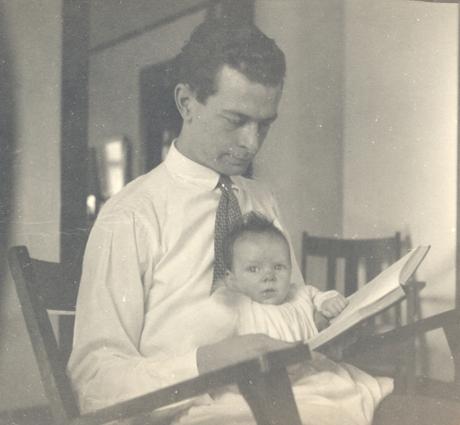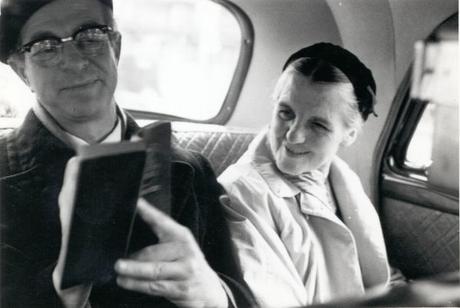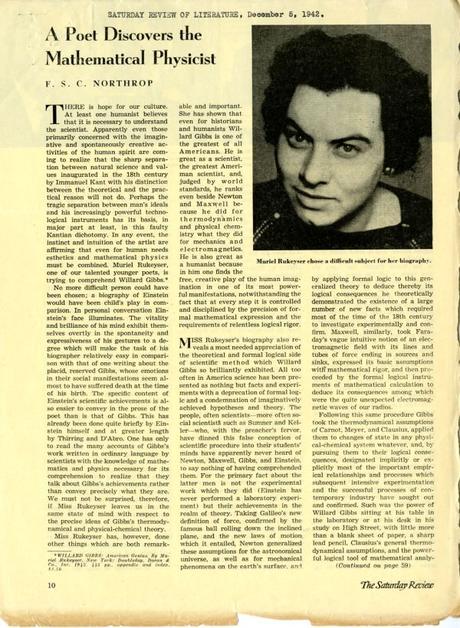 Linus Pauling, reading with Linus Jr., 1925.
Linus Pauling, reading with Linus Jr., 1925.[Happy 12th birthday to us! We began this venture in early March 2008 and today, nearly 800,000 words later, we’re excited to still be exploring the life and impact of Linus Pauling. We celebrate by continuing our close look at Pauling’s work for the Guggenheim Foundation.]
As a member of both the Committee of Selection and the Advisory Board for the John Simon Guggenheim Memorial Foundation, Linus Pauling not only read the thick application digests prepared by Foundation Secretary Henry Allen Moe each year, he also read books authored by select applicants. Doing so helped Pauling to make more informed decisions when casting his vote on whether or not to award a Fellowship. Given his background as a scientist, Pauling’s reading also helped Moe and other committee members better understand the nature and import of particular applicants’ work.
Some of the books that Pauling read during his time on the Committee aligned fairly closely to his scientific interests. Among these were Von Zahlen und Figuren by Hans Rademacher and Otto Toeplitz, and Mathematics and the Imagination by Edward Kasner and James R. Newman. Pauling also delved into books on history and sociology, The Mind of the South by W. J. Cash being one of them.
 Reading in Kyoto, Japan, 1955
Reading in Kyoto, Japan, 1955Fiction titles likewise made their way onto the reading list, including Jesse Stuart’s Taps for Private Tussie, Dorothy Baker’s Trio, Millen Brand’s Outward Room, Nelson Algren’s Never Come Morning, Lawrence Lipton’s Brother, the Laugh is Bitter, Paul Goodman’s Grand Piano and Don Juan, and Vladimir Nabokov’s Camera Obscura and The Real Life of Sebastian Knight.
Sometimes Pauling was able to read these books on his train rides home from Committee meetings in New York; when he reached Pasadena, he would send the books back to Moe and share his opinions. These evaluations were just as straightforward as those that he submitted when evaluating scientific proposals. He liked, for instance, Hugh MacLennan’s Barometer Rising, thought Wallace Stegner was “first rate,” and that Eudora Welty was a “crackerjack” offering “wonderful” stories.
His negative assessments were just as explicit. Vladimir Pozner’s First Harvest, was “lacking in penetration” and ill translated, Edward Newhouse was “good but rather flashy,” and Christina Stead was “no good” in part due to a style that was “labored and verbose.”
The fiction authors Pauling read for his first Committee of Selection meeting in 1940 were Christine Weston and Harold Sinclair. Pauling judged Sinclair to be “a first-class man” and expressed no objections to his fellowship being renewed, provided that he also be recommended by a specialist. (As it turned out, no specialist made such a recommendation and Sinclair’s support was not renewed. )
Pauling was more critical of Weston’s Be Thou the Bride, which followed two families in Maine through a tale of adultery, arson, and other dramatic events. For Pauling, the writing just wasn’t there, and in his report to Moe he suggested that
He [sic] is a careless writer, far from precise in the use of words and even capable of making gross grammatical errors. His [sic] thinking is similarly careless.
Unlike Sinclair though, the specialist assigned to Weston’s novel recommended it, and she was awarded a Fellowship that year. Weston would apply again in 1943 after having written Indigo, which was set in India around the time of the First World War. This time Pauling’s opinions were not recorded and Weston did not receive a Fellowship.

Pauling also read books that overlapped more directly with his areas of expertise. In 1942, Muriel Rukeyser had just published a biography of the nineteenth-century American physicist Willard Gibbs, and Moe was particularly interested in Pauling’s opinion of the text.
The reviews were mixed at best. While he found her “clever” and a good writer, it was clear to Pauling that Rukeyser did not understand Gibbs and had based much of her work on secondary sources. In one particularly glaring passage, Rukeyser had presented Gibbs’ phase rule as a definition when it was anything but. Moreover, when she applied the rule to specific cases, she conflated salt – as in sodium chloride – with the much broader category of salt compounds. Pauling then explained to Moe how he would write about the phase rule were he taking on Rukeyser’s project.
Interestingly enough, the criticism did not sink in. In his reply, Moe offered that it was “very sweet” of Pauling to help him understand some of the science, even though it had mostly remained impenetrable. Moe also noted that others to whom he had spoken, including Committee of Selection members E. B. Wilson and Florence R. Sabin, had liked Rukeyser’s book.
Pauling was frustrated by this response, writing Moe, “Damn it, I wasn’t trying to be sweet when I wrote to you about Miss Rukeyser’s book.” He explained again the nature of his complaints but also expressed a willingness to reassess if Moe did not think the criticisms relevant. The Committee of Selection must have thought they were not as Rukeyser was ultimately granted a Fellowship that year.
In other instances, Pauling’s opinion held serve. When anthropologist Victor von Hagen applied for a 1949 Fellowship, Pauling felt compelled to read his book, Aztec and Mayan Paper Makers, published a few years earlier.
Once done, Pauling came away less than impressed. The only argument that he found interesting was that the Aztecs and Maya had made paper from fig tree bark rather than agave, but even this struck Pauling as old news — he suspected “some German investigators” had made the discovery as early as 1910. The presence of typos – like setting the date of the first European paper mill in Mexico at 1850 rather than 1550 or 1580 – also grated. For Pauling the book did not justify a Fellowship, an assessment with which Moe and the rest of the committee agreed.

Herman and Nina Schneider, who wrote science books for children, applied for a 1952 Fellowship. In years past, they had published several titles including How Big is Big?, You Among the Stars, and Let’s Look Under the City. Pauling read them and was, once again, underwhelmed. While some of the experiments they described were clever, others were no good at all. Pauling noted that he had discussed the books with his son Peter, who pointed out that the authors’ were incorrect in describing how an ice cube in a mitten would stay colder longer than one left unwrapped. As Pauling told Moe, both of the ice cubes would remain at the same temperature, but the wrapped one would melt more slowly.
Pauling was also disappointed in the Schneiders’ illustrations. One depicting a passenger-laden ski lift placed the center of mass in the wrong location. Other images were confusing because of poor perspectives. On the contrary, Pauling found that Fritz Kahn’s Man in Structure and Function, though written for adults, showed the type of imagination needed for a children’s book. So while he did not support a fellowship for the Schneiders, he would for Kahn were he interested.
Being on the Guggenheim Foundation’s Committee of Selection gave Pauling the chance to read many books he would not have read otherwise. And like other experiences of being on the Committee, Pauling genuinely appreciated the opportunity, though his assessments did not always carry the day.
